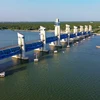Reducing greenhouse gases in agricultural production is currently a general trend in the world. In Vietnam, the Ministry of Agriculture and Rural Development has carried out many programmes and projects on adaptation to climate change, the Vietnam Business Forum Magazine (VBF) reported.
After a four-year pilot programme, the low carbon rice farming model is being considered for expansion in Vietnam.
From 2010 to 2012, the Institute of Mekong Delta Development Research Institute, the Hanoi Water Resources University and the Department of Agriculture and Rural Development of An Giang province jointly implemented the low-carbon rice farming project in Binh Hoa commune, Chau Thanh district, An Giang province. The project was funded by Environmental Defence Fund (EDF).
The second phase (2012-2014) was deployed by 400 farming households in Kenh B Cooperative, Thanh Dong A commune, Tan Hiep district (Kien Giang province) and Phu Thuong Cooperative, Phu Thanh commune, Phu Tan district (An Giang province), with a scale of 540 ha each crop.
Reviewing the performance of the second phase, Project Manager Tran Thu Ha said the new rice cultivation model reduced seed use by 50 percent, fertilisers by 30 percent, pesticides by 30 - 40 percent, water by 40 – 50 and labour by 20 - 30 percent, while raising productivity by 10 - 15 percent and farmers’ incomes by 5 - 10 percent. This rice farming model has reduced gas emissions per hectare per year by 7.7 tonnes in An Giang province and by 45 tonnes in Kien Giang province.
Not only reducing the amount of greenhouse gases emitted, cleaning up the environment, and increasing profits for farmers in the time of cutting costs for agricultural inputs and farming methods, this model also produces clean, safe and environment-friendly products, also known as bio-rice.
To reduce emissions in agriculture, the Ministry of Agriculture and Rural Development targeted to reduce emissions in horticulture.
Le Quoc Doanh, Deputy Minister of Agriculture and Rural Development, said the horticultural sector will apply advanced farming techniques and solutions to reduce water consumption and input costs; collect, reuse and treat straw thoroughly in order to minimize greenhouse gas (GHG) emissions and environmental pollution.
Together with these specific measures, the Ministry of Agriculture and Rural Development will study and complete GHG reduction methods in arable farming systems; complete cultivation processes to improve productivity, reduce emissions, study waste treating technologies, and reuse agricultural products to increase economic efficiency and reduce emissions.
At a forum on GHG emission reduction in agriculture held in Hanoi on September 17, 2014, Deputy Minister Le Quoc Doanh affirmed that the low carbon rice farming model produced positive results and the agricultural sector would consider expanding it in Vietnam to produce prestigious and high-quality rice to meet consumer requirements and build sustainable agriculture.-VNA
After a four-year pilot programme, the low carbon rice farming model is being considered for expansion in Vietnam.
From 2010 to 2012, the Institute of Mekong Delta Development Research Institute, the Hanoi Water Resources University and the Department of Agriculture and Rural Development of An Giang province jointly implemented the low-carbon rice farming project in Binh Hoa commune, Chau Thanh district, An Giang province. The project was funded by Environmental Defence Fund (EDF).
The second phase (2012-2014) was deployed by 400 farming households in Kenh B Cooperative, Thanh Dong A commune, Tan Hiep district (Kien Giang province) and Phu Thuong Cooperative, Phu Thanh commune, Phu Tan district (An Giang province), with a scale of 540 ha each crop.
Reviewing the performance of the second phase, Project Manager Tran Thu Ha said the new rice cultivation model reduced seed use by 50 percent, fertilisers by 30 percent, pesticides by 30 - 40 percent, water by 40 – 50 and labour by 20 - 30 percent, while raising productivity by 10 - 15 percent and farmers’ incomes by 5 - 10 percent. This rice farming model has reduced gas emissions per hectare per year by 7.7 tonnes in An Giang province and by 45 tonnes in Kien Giang province.
Not only reducing the amount of greenhouse gases emitted, cleaning up the environment, and increasing profits for farmers in the time of cutting costs for agricultural inputs and farming methods, this model also produces clean, safe and environment-friendly products, also known as bio-rice.
To reduce emissions in agriculture, the Ministry of Agriculture and Rural Development targeted to reduce emissions in horticulture.
Le Quoc Doanh, Deputy Minister of Agriculture and Rural Development, said the horticultural sector will apply advanced farming techniques and solutions to reduce water consumption and input costs; collect, reuse and treat straw thoroughly in order to minimize greenhouse gas (GHG) emissions and environmental pollution.
Together with these specific measures, the Ministry of Agriculture and Rural Development will study and complete GHG reduction methods in arable farming systems; complete cultivation processes to improve productivity, reduce emissions, study waste treating technologies, and reuse agricultural products to increase economic efficiency and reduce emissions.
At a forum on GHG emission reduction in agriculture held in Hanoi on September 17, 2014, Deputy Minister Le Quoc Doanh affirmed that the low carbon rice farming model produced positive results and the agricultural sector would consider expanding it in Vietnam to produce prestigious and high-quality rice to meet consumer requirements and build sustainable agriculture.-VNA



















